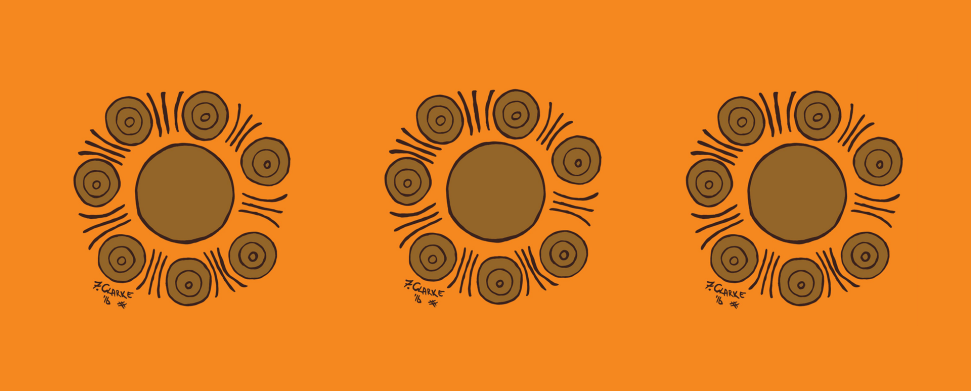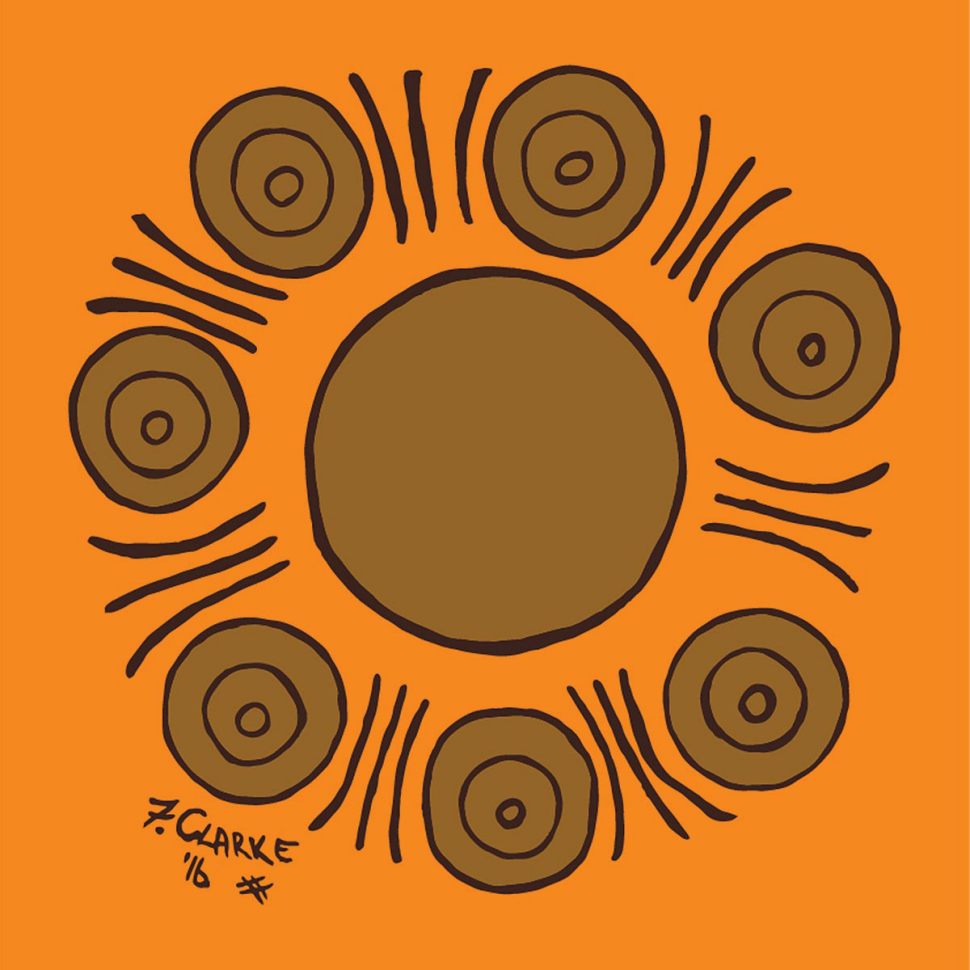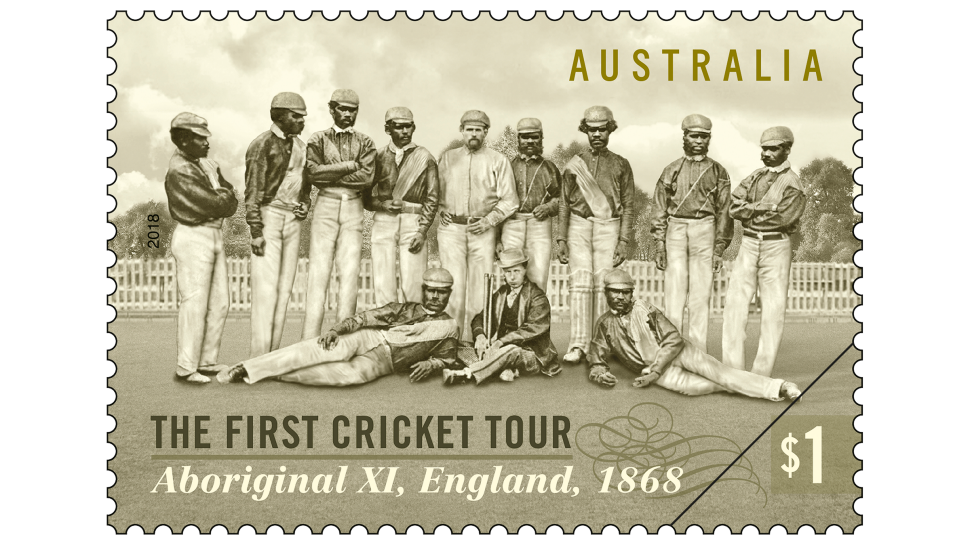Kirrae Whurrong artist Fiona Clarke has been practising her craft for more than two decades, spanning painting on canvas and tapestry weaving, as well as public art installation and sculpture. In fact, visitors to Birrarung Marr, in Melbourne, may be aware of Fiona’s collaboration with her husband, artist Ken McKean – a sculpture commissioned by the City of Melbourne, titled Eel Trap. Fiona’s rich and vibrant works describe the activities of her childhood and tell the stories of her ancestors.
In fact, Fiona says that ancestors are her greatest artistic influence. This is unsurprising, when you consider who some of these ancestors are. Firstly, there’s her father – the late Banjo Clarke, a highly respected Aboriginal elder born near Warrnambool in the 1920s, who passed away in 2000. Banjo Clarke was known and cherished for his love of his traditional lands and his people, his kindness towards anyone in need, and his sincere belief in reconciliation through education and understanding.
Then there’s Fiona Clarke’s great-great-grandfather James “Mosquito” Couzens (Grougarrong) and his brother Johnny Cuzens (Zellanach), both members of the historic 1866 and 1868 Aboriginal XI cricket teams. (The different spelling of the brothers’ surnames probably came from the tendency of white settlers to create and misspell names for Aboriginal people, and it’s believed that the nickname “Mosquito” came from James Couzens’ likely birthplace, Mosquito Plains (now Naracoorte), in South Australia.)
The 1866 Boxing Day match between an Aboriginal XI and the Melbourne Cricket Club, held at the Melbourne Cricket Ground (MCG), introduced cricket fans to the talents of Aboriginal cricketers, most of whom had begun playing the game just a few years earlier on the various pastoral stations where they lived and worked, in the Western District of Victoria. The enthusiastic response to the match inspired the idea of a privately sponsored tour of England, which occurred two years later in 1868.
The 1868 cricket tour was ground-breaking in the sense that this was the first team from Australia to tour internationally, and the fourth team from anywhere (the three previous international tours were by English teams, including two visits to Australia, in 1861–62 and 1863–64). Also ground-breaking in that the Aboriginal XI equalled the record of their opponents, by winning 14, losing 14 and drawing 19 of their 47 matches. The success of the tour is said to have paved the way for the first Australian representative tour of England, which occurred ten years later, and is covered in our post Commemorating the first cricket tour to England.
Fiona Clarke designed the artwork Walkabout Wickets in honour of these pioneering players. Fiona created the artwork for Cricket Australia, as part of 150 year anniversary celebrations of the 1866 match, held at the MCG. The 2016 Boxing Day Test between Australia and Pakistan was dedicated to the memory of the 1866 and 1868 Aboriginal teams, and the players' shirts, the stumps and the signage at the ground featured this striking artwork.
“The painting represents past, present and future Aboriginal cricketers. The circles signify the teams’ various meeting places, and the wickets appear with no stumps, to convey that the game continually moves on,” says Fiona.
The evocative artwork forms the basis of the postmark associated with the commemorative stamp issue eleased on 1 May 2018, The First Cricket Tour: 150 Years. The stamp, designed by Phil Ellett of Creative Ethos, pays tribute to the 1868 Aboriginal XI and their incredible achievements. The first day of issue location is Edenhope, Victoria (previously known as Lake Wallace), which is where the players trained prior to the tour.
“It is a great honour to have ‘Walkabout Wickets’ used as a postmark. I am so proud of my ancestors James Couzens (my great-great-grandfather) and Johnny Cuzens (my great-great-great uncle) who played in the 1866 and 1868 in the first Aboriginal XI. They played a large part in my love for cricket. I hope they and I inspire more my Aboriginal people to play cricket now and into the future. I would like to see more Aboriginal people play for Australia,” says Fiona.
“Aunty Fiona’s artwork is incredible and we are so fortunate to have an ancestor of players from 1868 so committed to helping us share this story with the nation,” says Paul Stewart, Cricket Australia’s Indigenous Engagement Specialist.
“Having Australia Post amplify this year’s commemoration of the 1868 team with a postage stamp that incorporates Fiona’s artwork on the postmark is a wonderful tribute to this remarkable story. The 1866 and 1868 teams were pioneers for our sport and is a story all Australians should make an effort to learn. This year being 150 years since that historic tour to the UK gives us a chance to create a new generation of storytellers and ensure their legacy is never forgotten,” adds Paul.
Fiona Clarke has an Advanced Diploma of Fine Art and an Associate Diploma of Studio Textiles, and has held many solo exhibitions, including at the Melbourne Museum and, most recently, at Warrnambool Art Gallery, which invited her to show her work as part of the exhibition, ‘An Ever Present Universe’ which includes her most recent work and her series on the traditional Aboriginal story, ’The Seven Sisters’. Fiona’s storytelling has also made it into book form, with the publication of a children’s book, Minkgill Chases the Rainbow (One Day Hill, 2012).
The artwork Walkabout Wickets appears on the postmark with the permission of Cricket Australia and artist Fiona Clarke.
The First Cricket Tour: 150 Years stamp issue is on sale from 1 May 2018, online, at participating Post Offices and via mail order on 1800 331 794, while stocks last.
View the gallery and technical details from this issue
This article was produced at the time of publication and will not be updated.




